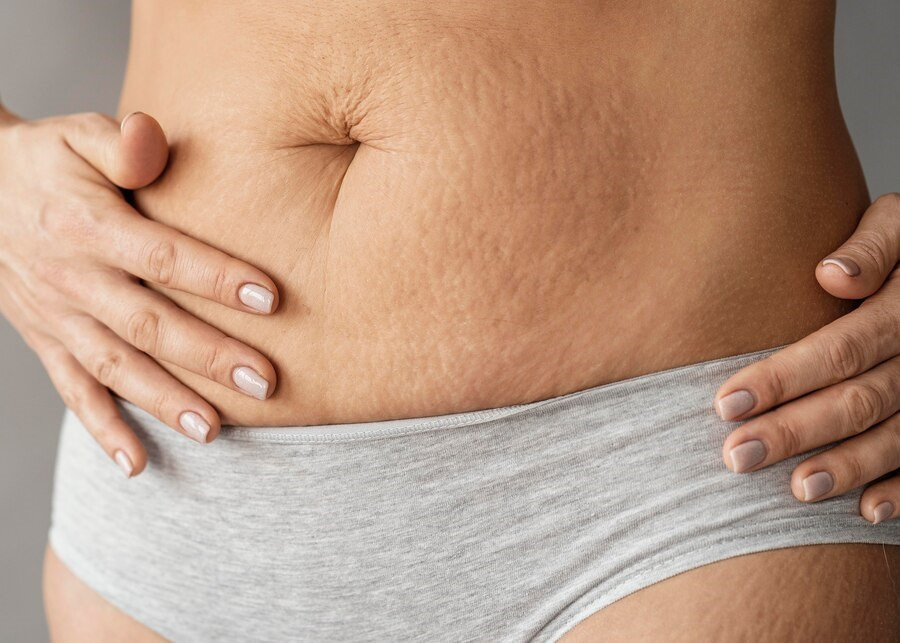Stretch marks are a common complaint among women, especially pregnant women. These white, fiber-like lines typically appear in the folds of the stomach, breasts, and thighs. Stretch marks are generally completely benign and are not considered a significant risk for personal health. However, stretch marks may cause certain individuals to feel insecure and less confident.
Causes of Stretch Marks
The most common causes of stretch marks are rapid weight gain and excessive skin stretching. Stretch marks are common in pregnant women because of the weight gain that occurs during pregnancy.
The breasts, thighs, stomach, and other places that experience size changes and elevated skin tension during pregnancy could develop these stretch marks. Although they are more common in women, stretch marks can also occur in men.
In addition to pregnancy, a number of other factors can result in the appearance of stretch marks, such as:
Adolescent body changes
Due to accelerated growth, stretch marks can also develop during adolescence, particularly when there are notable weight fluctuations. Teenagers' bodies may also have stretch marks due to genetic factors.
Weight lifting exercise
Stretch marks on the arms or shoulders are common in people who lift weights frequently and are overweight or obese. This is typical since excessive skin stretching can also result from fast muscle growth.
Warming up and staying hydrated during training can help prevent stretch marks caused by intense exercise. You may also need to take your time increasing exercise intensity and gradually allowing your body to adapt, which will help reduce the risk of stretch marks.
Steroid use
Steroids in skin care creams are commonly used to reduce inflammation in the skin, relieve itching, reduce redness and swelling, and are effective in the treatment of psoriasis, burns, and Lupus.
Long-term use of steroids may cause skin thinning. The risk of stretch marks increases as the skin thins and loses elasticity. The skin is also more vulnerable to cuts and other injuries.
Cushing's syndrome and Marfan's syndrome
Cushing's syndrome is a condition characterized by elevated levels of the hormone cortisol in the body, such as during long-term steroid use. Long-term steroid use causes physiological disorders, specifically excessive cortisol production. Cushing's syndrome is characterized by stretch marks on the stomach, thighs, arms, and back.
Meanwhile, Marfan syndrome is a genetic condition that affects the body's connective tissues. Stretch marks may appear as a symptom of this syndrome due to rapid and significant body growth.
Is It Possible to Remove Stretch Marks?
Creams, lotions, and gels claiming to remove stretch marks are ineffective. Experts recommend using products that claim to remove stretch marks as soon as possible to avoid the development of stretch marks. Massage the stretch mark area with cream, lotion, or gel regularly for several weeks until the results are visible.
Aside from that, stretch marks can be reduced by using hyaluronic acid and tretinoin in the amounts recommended by the doctor. If you want to effectively remove stretch marks, you should consider procedures like chemical peeling, laser therapy, microdermabrasion, radiofrequency, and plastic surgery. If you need to learn more about stretch marks and their treatment, you can either visit a doctor or make use of the consultation features that are available in the Ai Care application by downloading the Ai Care application from the App Store or Play Store.
Looking for more information about other diseases? Click here!
- dr. Alvidiani Agustina Damanik
Susan Bernstein (2023). Stretch Marks. Available from: https://www.webmd.com/beauty/what-are-stretch-marks
Mayo Clinic (2023). Stretch marks. Available from: https://www.mayoclinic.org/diseases-conditions/stretch-marks/symptoms-causes/syc-20351139
American Academy of Dermatology Association. Stretch Marks: Why They Appear and How to Get Rid of Them. Available from: https://www.aad.org/public/cosmetic/scars-stretch-marks/stretch-marks-why-appear
Prenancy Birth and Baby (2022). Stretch marks. Available from: https://www.pregnancybirthbaby.org.au/stretch-marks
Kevin P. Boyd, MD (2022). Are stretch marks normal for teens?. Available from: https://www.mayoclinichealthsystem.org/hometown-health/speaking-of-health/are-stretch-marks-normal-for-teens
Tessa Sawyers (2018). Are Stretch Marks on Shoulders Normal?. Available from: https://www.healthline.com/health/are-stretch-marks-on-shoulders-normal
Ashley Welch (2022). Stretch Marks: Why They Happen and How to Treat Them. Available from: https://www.everydayhealth.com/skin-beauty/stretch-marks-why-they-happen-and-how-to-treat-them/
Heather L. Brannon, MD (2023). Topical Steroid Side Effects. Available from: https://www.verywellhealth.com/steroids-topical-steroid-side-effects-1068831
Mayo Clinic (2023). Cushing syndrome. Available from: https://www.mayoclinic.org/diseases-conditions/cushing-syndrome/symptoms-causes/syc-20351310











